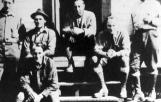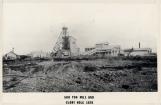1
In the middle of the island of Newfoundland, a subterranean ore deposit lay, waiting for discovery. Some of the minerals could be seen as the the river had stripped away some of the ground covering the orebody. When the ore was exposed to water and oxygen it turned the grey metal sulphides into reddish brown and yellow oxides. At the turn of the century, England's paper supply was threatened by the worry of war in Europe. The Harmsworth bothers, owners of the The Daily Mail, looked to the colony of Newfoundland for an alternate supply of newsprint. Also, Promoter, Harry J. Crowe formed a partnership with William D. Reid, Manager of the Reid Newfoundland Company to acquire sawmill operations in central Newfoundland. An agreement between Reid and the Anglo Newfoundland Development Company (A.N.D) stated that a survey and inventory of the land would be conducted. The A.N.D. Company hired Michael S. Sullivan and William F. Canning to conduct the survey along with guide, Mattie Mitchell. The primary material that the A.N.D. Co. was interested in finding was sulphur, an important ingredient in the process of newsprint manufacture. In September, 1905, Canning and Mitchell travelled from Millertown to the mouth of Buchans River (Sandy River) as part of the survey party for the extensive land holdings. This survey would lead to the discovery and development of the Buchans mines.2
Mattie Mitchell, a Mi'kmaq Montagnais trapper and prospector for the AND company.1905
Buchans River, Buchans, Newfoundland, Canada

3
The discovery of ore on the Buchans River is attributed to Mattie Mitchell, a Mi'kmaq Montagnais trapper and guide. The legend goes that Mitchell was having a 'mug up' on the river when the heat from his campfire melted a nearby rock. Mitchell thought this may be of importance and brought it to the attention of Canning. Mitchell's discovery would eventually bring about the development of one of the largest mining operations in Newfoundland and the community of Buchans.5
From 1905 to 1926, the A.N.D Company made several attempts to identify a process of separating of the ore from the rock. In 1911, the mine was closed since a profitable method of separation could not be found.In 1915, Mr. H.A. Guess, vice-president in charge of mining of the American Smelting and Refining Company (ASARCO) became interested in the Buchans orebody. Finally, in 1925, at the ASARCO Metallurgical Laboratory at Flat River, Missouri, scientists perfected the floatation method of separation and used it on ore samples from Buchans. ASARCO and the A.N.D Company agreed to a fifty-fifty share of profits from the mine in a twenty-five year lease on March 18, 1928.
6
The first geology team in Buchans and the crew who discovered the Lucky Strike mine site in 1926.1926
Buchans, Newfoundland, Canada



